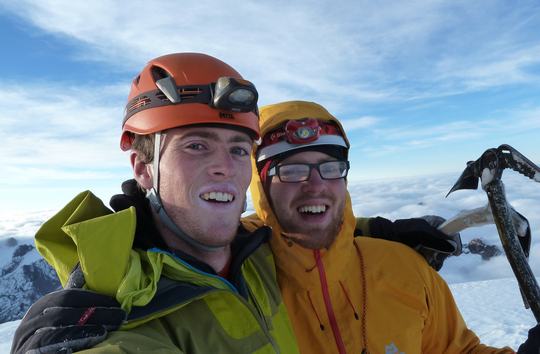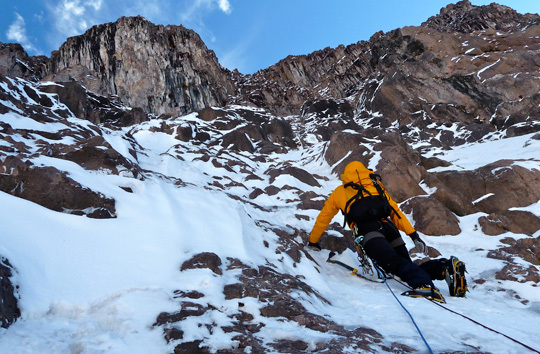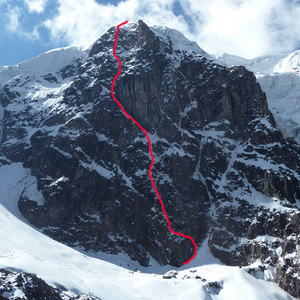
Hamish Dunn and Tom Ripley on the summit of Chichicapac (5614m), just after climbing a new route up the mountain’s south face. [Photo] Hamish Dunn
Young British climbers Tom Ripley and Hamish Dunn established a new route on the previously-unclimbed south face of Chichicapac (5614m) in the Cordillera Carabaya massif in southern Peru. Dunn and Ripley completed their new, unnamed route (TD, 700m) on August 22, 2011.
The Cordillera Carabaya massif is comprised of six summits over 5000m. The first exploration of the area occurred in the 1950s and 1960s. In 2005, the first commercially organized expedition to the area (headed by Scotland’s John Biggar and local Pere Vilasau) ended a thirty-year dry spell of new routes–before then, the last recorded new route in the Cordillera Carabaya had been established in 1981.
Recent activity in the Cordillera Carabaya has centered on Chichicapac. Italian climbers Piero Ghiglione and Forrunaro Mautino first climbed the 5614-meter peak in 1959, and in 2007, British climbers Mike Cocker, Jonathan Preston and Stephan Reid attempted the south face of Chichicapac. Cocker, Preston and Reid changed their plans upon reaching the south face and realizing that it was threatened by overhanging seracs; instead, they established a new route on the north ridge of the mountain.

Ripley climbing low on the face. [Photo] Hamish Dunn
Photos from Reid’s 2007 expedition inspired his friend, Ripley, to visit the area. After an unsuccessful and wet expedition to the Karakorum in 2010, Ripley decided to visit the Cordillera Carabaya. He was drawn by the potential for new routes, the promise of stable weather and simpler travel logistics than those in Central Asia.
Dunn and Ripley’s route climbs the center of the south face of Chichicapac. They found the rock to be “generally terrible” and very loose. The first part of the route was unstable mixed climbing, with sustained difficulty of Scottish IV/V. A loose rock chimney is followed by a crux pitch (Scottish grade VI); the route then mellows to an easy snow slope and the summit plateau. Protection was rare
Eight inches of snow fell two days prior to the pair’s ascent, so a think layer of powder accumulated on top of the solid neve on the mountain. Aside from that storm, weather was stable and ideal for climbing: hot, sunny and windy in the day, with nighttime temperatures dipping to -5 C.
Dunn and Ripley spent ten hours completing their new route. In the short winter days of the southern hemisphere, the sun was close to setting when they summited. The climbers quickly descended via Chichicapac’s west ridge and rappelled onto the neighboring glacier and trudged back to their camp.

Hamish Dunn and Tom Ripley’s line of ascent on the south face of Chichicapac (5163m).
Ripley is especially proud of their new route as it is his first new route in the greater ranges. “It felt pretty special being the first people to top out on a face with no other climbs on it.”